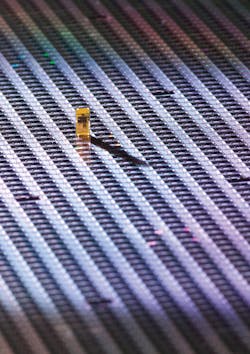Information Technology: Aircraft Components Get Smart
From start to future
Originally radio frequency identification (RFID) saw adoption in the retail supply chain where low-memory tags stayed in climate-controlled stores for short durations. In those first deployments, the RFID tag was read-only; it transmitted an identification number, which was primarily used as an index into an inventory database.
While numerous types of tags have existed for many years, what’s been missing is the chip technology that can enable truly “smart assets” thereby taking RFID to a whole new level. Now it’s not about the tags, it’s about the information they manage.
RFID technology has been making its way into the aerospace industry for several years now, and it’s starting to change the way suppliers, airframe manufacturers, airlines, and maintenance organizations approach their jobs. Now RFID tags can store everything from the simple information often found on an identification placard such as part number, serial number, and expiration dates to detailed historical MRO information typically stored in a centralized database. And with the tag physically attached to a particular component, the information is easily associated with that component.
Many tags in production today have specifically targeted flyable parts. Industry standards address environmental factors such as humidity, pressure, and flammability. Tags that meet these standards can be used in external aircraft locations as well as pressurized cabin spaces.
Using standard reader equipment, aircraft maintenance staff can read a part’s condition information from its attached tag; information that was formerly accessible only by opening difficult to reach or secured areas in order to read the unit's data nameplate.
Ultimately, the same information can be shared across the supply chain between the operator and the maintenance organization, from one MRO to another, and between inventory management staff and parts suppliers. Technicians can immediately determine component status in the field in an efficient and economical manner.
“Smart” aircraft components
By building on current RFID technology, new capabilities are being developed that go beyond what has been typically thought of as RFID. For example, Tego Inc. has made advances in semiconductor technology to create RFID tags with up to 8 kilobytes of usable space, more than 640 times the memory capacity of those first 96-bit retail tags. Additionally, specialized processing capabilities have been added to the high-memory semiconductor chips, which allow part information to be indexed and accessed with greater speed and ease.
With these latest innovations we are turning components on an aircraft into “smart assets” that can assist maintenance staff with making on-the-spot decisions. A smart asset can store and communicate information about its history throughout its lifecycle. Whether an asset stays in one place or moves around, the information remains intact throughout the asset’s life, potentially decades. That information can be vast, taking the form of historical maintenance records or scratchpad messages from one technician to another. It could also be the airworthiness certificate from the MRO that completed the last overhaul or modification.
This technology provides the ability to share critical data about the asset with those who are responsible for its maintenance and performance over time. Maintenance staff can read about the asset, location/position on the aircraft, service/maintain or replace it as necessary, and then document the action directly on the part.
Information where you want it when you need it
For maintenance activities, it ultimately comes down to having all of the information in one place at the time it’s needed. Yet information can end up in many different places throughout the lifecycle of an aircraft part. This is typically what happens at each stage:
Parts manufacturer: Records critical data, i.e., part number, serial number, date of manufacture, when it’s shipped. Some data goes on the nameplate; other data is written down on hardcopy records, and/or in an electronic database. Some information is shipped along with the part; some stays behind with the manufacturer.
Airframe manufacturer – receiving: Receives the part, takes whatever data came along with it, and adds its own, i.e., date received, shipping carrier, warehouse location. This information is now stored in its own system.
Airframe manufacturer – assembly line: Installs the part on an aircraft and additional data is generated, i.e., location on aircraft, date of installation. This information typically stays behind with the manufacturer after the aircraft is delivered to a customer.
Aircraft owner/operator: Performs in-service maintenance activities; stores identification information and records related to maintenance and replacement tasks. This data is property of the airline.
Maintenance repair and overhaul organization: Stores historical record information, in-service maintenance tasks, overhaul records, engineering, and modification status, etc. Data from the owner/operator would help the MRO process but is difficult to access.
Not having updated information follow a part throughout its lifecycle creates one of the biggest challenges for an MRO organization. If the part is actually a smart asset, the situation is much different. Using a handheld reader, the maintenance crew can instantly learn the manufacturer’s CAGE code, the current part number, who did the last installation. That data is now known with certainty, without a database lookup and with the confidence that it refers to the part in hand. After a part is changed or repaired, technicians can write the new activity information back to the part. They can also upload the new information to a Maintenance Information System database reducing their administrative time and risk of manual error.
Smart assets will soon have the capability of forming a complete information system that can capture, compute, communicate, and collaborate around the data they contain adding a whole new level of intelligence and efficiency to MRO operations. By also embedding input devices like sensors, and output devices like displays, indicators, or controls, smart assets will be able to automatically monitor and interact with their environment without human participation, a distinct advantage in remote or inhospitable locations.
About the author. Bob Hamlin is chief technology officer at Tego, the leading provider of high memory RFID tagging solutions. Bob may be reached at [email protected]

